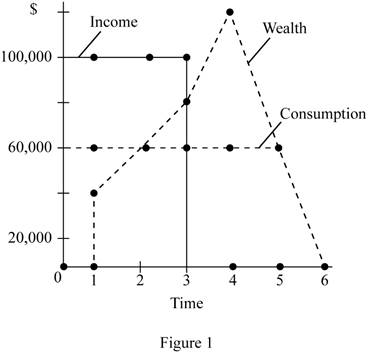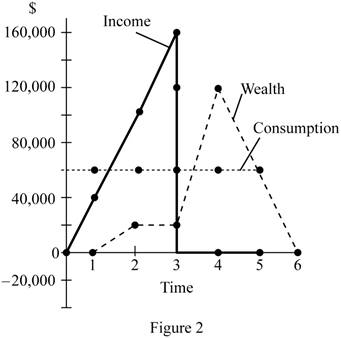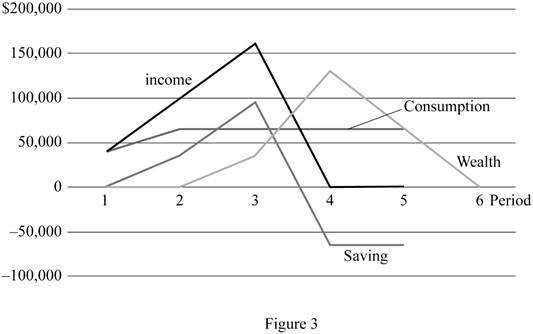
(a)
Consumption and saving.
(a)
Explanation of Solution
According to the life-cycle model of consumption, the consumption of an individual depends on the income earned in the entire life time of an individual.
The total life time income of the individuals can be calculated as the sum of income they earn in different periods using Equation (1) as follows:
Given that A enjoys $100,000 in three periods and F enjoys $40,000 in period1, $100,000 in period2, and $160,000 in period3, both individuals consume for 5 periods in life.
The life-time income of A can be calculated by substituting the respective values in Equation (1) as follows:
Thus, the life-time income of A is $300,000.
The life-time income of F can be calculated by substituting the respective values in Equation (1) as follows:
Thus, the life-time income of F is $300,000.
The life-time consumption of individuals can be calculated using Equation (2) as follows:
The life-time consumption of A can be calculated by substituting the respective values in Equation (2) as follows:
The life-time consumption of A is $60,000.
The life-time consumption of F can be calculated by substituting the respective values in Equation (2) as follows:
The life-time consumption of F is $60,000.
The savings can be calculated as the part of income, which is not consumed. The savings can be calculated using Equation (3) as follows:
The saving in period 1 for A can be calculated by substituting the respective value in Equation (3) as follows:
Thus, A’ savings for period 1 is $40,000.
Table 1 shows the values of savings for A and F in different periods calculated using Equations 1, 2, and 3.
Table 1
| A | F | |
| S1 | 40,000 | -20,000 |
| S2 | 40,000 | 40,000 |
| S3 | 40,000 | 100,000 |
| S4 | -60,000 | -60,000 |
| S5 | -60,000 | -60,000 |
Life-cycle theory: Life-cycle theory developed by Franco Modigliani and Richard Brumberg relates the spending and saving habits of an individual to the course of their life time.
Savings: Savings is defined as that part of income that is not consumed in the current period and is to be used for future consumption.
(b)
The wealth of individuals.
(b)
Explanation of Solution
The wealth of an individual is calculated as the accumulated saving in each period.
The wealth can be calculated using Equation (4) as follows:
The wealth of individual A in the beginning of period 2 is calculated by substituting the respective values in Equation (4) as follows:
Thus, the wealth of A in the beginning of period 2 is $40,000.
Table 2 shows the values of wealth for A and F in different periods, which are calculated using Equation 4.
Table 1
| A | F | |
| W1 | 0 | 0 |
| W2 | 40,000 | -20,000 |
| W3 | 80,000 | 20,000 |
| W4 | 120,000 | 120,000 |
| W5 | 60,000 | 60,000 |
| W6 | 0 | 0 |
It is evident from the table values that there is no wealth in period1 and period 6.
(c)
The graphical representation of consumption, income, and wealth of the individuals.
(c)
Explanation of Solution
Figure 1 given below shows the consumption, income, and wealth of A.

The horizontal axis of Figure 1 measures the time period, and the vertical axis measures the consumption, income, and wealth. A enjoys a fixed income over the first 3 periods, and hence he also has a constant pattern of consumption as clearly depicted in Figure 1. A saves a part of his income and thus gradually increases his wealth during his earning years and gradually dissaves when he leads his retirement life. His pattern of consumption, income, and wealth is according to the prediction of the life-cycle model.
Figure 2 given below shows the consumption, income, and wealth of F.

The horizontal axis of Figure 1 measures the time period, and the vertical axis measures the consumption, income, and wealth. F increases his income gradually, and this would force him to borrow initially to enjoy a smooth consumption. When his income increases, he would accumulate wealth and then use it for his consumption in the retirement life.
Savings: Savings is defined as that part of income that is not consumed in the current period and is to be used for future consumption.
Dissaving: The act of spending more than earned in the current period or spending the past savings is known as dissaving.
(d)
The impact of borrowing.
(d)
Explanation of Solution
A has fixed income from the initial years of earning, and hence there is no need for him to borrow. Thus, A’s consumption or income will not be affected when there is a borrowing constraint. However, F depends on borrowing for his initial period. When there is a borrowing constraint, F has to spend his entire income of $40,000 in the initial period. For the later periods, he smooths his consumption by dividing the lifetime income across the remaining periods.
The life-time income of F can be calculated by substituting the respective values in Equation (1) as follows:
Thus, the life-time income of F is $260,000.
The life-time consumption of F can be calculated by substituting the respective values in Equation (2) as follows:
The life-time consumption of F is $65,000.
The saving in period 2 for F can be calculated by substituting the respective values in Equation (3) as follows:
Thus, F’s savings for period 2 is $35,000.
The wealth of individual F in the beginning of period 2 is calculated by substituting the respective values in Equation (4) as follows:
Thus, the wealth of A in the beginning of period 2 is $40,000.
Table 2 shows the values of savings and wealth F in different periods, which are calculated using Equations 3 and 4.
Table 1
| Period | F's Consumption | F's Savings | F's Wealth |
| 0 | 0 | 0 | 0 |
| 1 | 40,000 | 0 | 0 |
| 2 | 65,000 | 35,000 | 35,000 |
| 3 | 65,000 | 95,000 | 130,000 |
| 4 | 65,000 | -65,000 | 65,000 |
| 5 | 65,000 | -65,000 | 0 |
Figure 3 given below shows the consumption, income, and wealth of F.

The horizontal axis of Figure 1 measures the time period, and the vertical axis measures the consumption, income, and wealth. F increases his income gradually. However, he faces borrowing constraints, and hence he can only use his initial income for consumption. When his income increases, he would accumulate wealth, and then use it for his consumption in the retirement life.
Savings: Savings is defined as that part of income that is not consumed in the current period and is to be used for future consumption.
Dissaving: The act of spending more than earned in the current period or spending the past savings is known as dissaving.
Want to see more full solutions like this?
- Can you please help with this one. Some economists argue that taxing consumption is more efficient than taxing income. Following the same argument, the minister of finance of a country introduced a new tax for sugar based products “sugar tax” to promote healthy eating in the economy. Please use relevant diagrams to explain the impact of the tax on consumers, producers and the tax revenue when sugar is elastic and inelastic.arrow_forwardprofit maximizing and loss minamization fire dragon co mindtaparrow_forwardProblem 3 You are given the following demand for European luxury automobiles: Q=1,000 P-0.5.2/1.6 where P-Price of European luxury cars PA = Price of American luxury cars P, Price of Japanese luxury cars I= Annual income of car buyers Assume that each of the coefficients is statistically significant (i.e., that they passed the t-test). On the basis of the information given, answer the following questions 1. Comment on the degree of substitutability between European and American luxury cars and between European and Japanese luxury cars. Explain some possible reasons for the results in the equation. 2. Comment on the coefficient for the income variable. Is this result what you would expect? Explain. 3. Comment on the coefficient of the European car price variable. Is that what you would expect? Explain.arrow_forward
- Problem 2: A manufacturer of computer workstations gathered average monthly sales figures from its 56 branch offices and dealerships across the country and estimated the following demand for its product: Q=+15,000-2.80P+150A+0.3P+0.35Pm+0.2Pc (5,234) (1.29) (175) (0.12) (0.17) (0.13) R²=0.68 SER 786 F=21.25 The variables and their assumed values are P = Price of basic model = 7,000 Q==Quantity A = Advertising expenditures (in thousands) = 52 P = Average price of a personal computer = 4,000 P. Average price of a minicomputer = 15,000 Pe Average price of a leading competitor's workstation = 8,000 1. Compute the elasticities for each variable. On this basis, discuss the relative impact that each variable has on the demand. What implications do these results have for the firm's marketing and pricing policies? 2. Conduct a t-test for the statistical significance of each variable. In each case, state whether a one-tail or two-tail test is required. What difference, if any, does it make to…arrow_forwardYou are the manager of a large automobile dealership who wants to learn more about the effective- ness of various discounts offered to customers over the past 14 months. Following are the average negotiated prices for each month and the quantities sold of a basic model (adjusted for various options) over this period of time. 1. Graph this information on a scatter plot. Estimate the demand equation. What do the regression results indicate about the desirability of discounting the price? Explain. Month Price Quantity Jan. 12,500 15 Feb. 12,200 17 Mar. 11,900 16 Apr. 12,000 18 May 11,800 20 June 12,500 18 July 11,700 22 Aug. 12,100 15 Sept. 11,400 22 Oct. 11,400 25 Nov. 11,200 24 Dec. 11,000 30 Jan. 10,800 25 Feb. 10,000 28 2. What other factors besides price might be included in this equation? Do you foresee any difficulty in obtaining these additional data or incorporating them in the regression analysis?arrow_forwardsimple steps on how it should look like on excelarrow_forward
- Consider options on a stock that does not pay dividends.The stock price is $100 per share, and the risk-free interest rate is 10%.Thestock moves randomly with u=1.25and d=1/u Use Excel to calculate the premium of a10-year call with a strike of $100.arrow_forwardCompute the Fourier sine and cosine transforms of f(x) = e.arrow_forwardDon't use ai to answer I will report you answerarrow_forward



 Macroeconomics: Private and Public Choice (MindTa...EconomicsISBN:9781305506756Author:James D. Gwartney, Richard L. Stroup, Russell S. Sobel, David A. MacphersonPublisher:Cengage Learning
Macroeconomics: Private and Public Choice (MindTa...EconomicsISBN:9781305506756Author:James D. Gwartney, Richard L. Stroup, Russell S. Sobel, David A. MacphersonPublisher:Cengage Learning Economics: Private and Public Choice (MindTap Cou...EconomicsISBN:9781305506725Author:James D. Gwartney, Richard L. Stroup, Russell S. Sobel, David A. MacphersonPublisher:Cengage Learning
Economics: Private and Public Choice (MindTap Cou...EconomicsISBN:9781305506725Author:James D. Gwartney, Richard L. Stroup, Russell S. Sobel, David A. MacphersonPublisher:Cengage Learning





